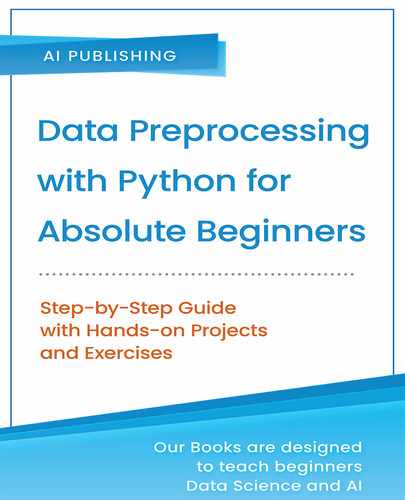This book is dedicated to data preparation and explains how to perform different data preparation techniques on various datasets using different data preparation libraries written in the Python programming language. The book follows a straightforward approach. It is divided into nine chapters. Chapter 1 introduces the basic concept of data preparation and installation steps for the software that we will need to perform data preparation in this book. Chapter 1 also contains a crash course on Python, followed by a brief overview of different data types in Chapter 2. You will then learn how to handle missing values in the data, while the categorical encoding of numeric data is explained in Chapter 4. The second half of the course presents data discretization and describes the handling of outliers' process. Chapter 7 demonstrates how to scale features in the dataset. Subsequent chapters teach you to handle mixed and DateTime data type, balance data, and practice resampling. A full data preparation final project is also available at the end of the book. Different types of data preprocessing techniques have been explained theoretically, followed by practical examples in each chapter. Each chapter also contains an exercise that students can use to evaluate their understanding of the chapter's concepts. By the end of this course, you will have built a solid working knowledge in data preparation-the first steps to any data science or machine learning career and an essential skillset for any aspiring developer. The code bundle for this course is available at https://www.aispublishing.net/book-data-preprocessing In addition to beginners in data preparation with Python, this book can also be used as a reference manual by intermediate and experienced programmers. It contains data preprocessing code samples using multiple data visualization libraries.Key Features
Book Description
What you will learn
Who this book is for
Table of Contents
- Cover Page
- Title Page
- Copyright
- How to contact us
- About the Publisher
- AI Publishing Is Searching for Authors Like You
- Download the Color Images
- Get in Touch with Us
- Table of Contents
- Preface
- About the Author
- Chapter 1: Introduction
- 1.1. What is Data Preparation?
- 1.2. Environment Setup
- 1.2.1. Windows Setup
- 1.2.2. Mac Setup
- 1.2.3. Linux Setup
- 1.3. Python Crash Course
- 1.3.1. Writing Your First Program
- 1.3.2. Python Variables and Data Types
- 1.3.3. Python Operators
- 1.3.4. Conditional Statements
- 1.3.5. Iteration Statements
- 1.3.6. Functions
- 1.3.7. Objects and Classes
- 1.4. Different Libraries for Data Preparation
- 1.4.1. NumPy
- 1.4.2. Scikit Learn
- 1.4.3. Matplotlib
- 1.4.4. Seaborn
- 1.4.5. Pandas
- Exercise 1.1
- Exercise 1.2
- Chapter 2: Understanding Data Types
- 2.1. Introduction
- 2.1.1. What Is a Variable?
- 2.1.2. Data Types
- 2.2. Numerical Data
- 2.2.1. Discrete Data
- 2.2.2. Continuous Data
- 2.2.3. Binary Data
- 2.3. Categorical Data
- 2.3.1. Ordinal Data
- 2.3.2. Nominal Data
- 2.4. Date and Time Data
- 2.5. Mixed Data Type
- 2.6. Missing Values
- 2.6.1. Causes of Missing Data
- 2.6.2. Disadvantages of Missing Data
- 2.6.3. Mechanism Behind Missing Values
- 2.7. Cardinality in Categorical Data
- 2.8. Probability Distribution
- 2.9. Outliers
- Exercise 2.1
- Chapter 3: Handling Missing Data
- 3.1. Introduction
- 3.2. Complete Case Analysis
- 3.3. Handling Missing Numerical Data
- 3.3.1. Mean or Median Imputation
- 3.3.2. End of Distribution Imputation
- 3.3.3. Arbitrary Value Imputation
- 3.4. Handling Missing Categorical Data
- 3.4.1. Frequent Category Imputation
- 3.4.2. Missing Category Imputation
- Exercise 3.1
- Exercise 3.2
- Chapter 4: Encoding Categorical Data
- Chapter 5: Data Discretization
- Chapter 6: Outlier Handling
- Chapter 7: Feature Scaling
- Chapter 8: Handling Mixed and DateTime Variables
- Chapter 9: Handling Imbalanced Datasets
- Final Project – A Complete Data Preparation Pipeline
- Exercise Solutions
- Back Cover
